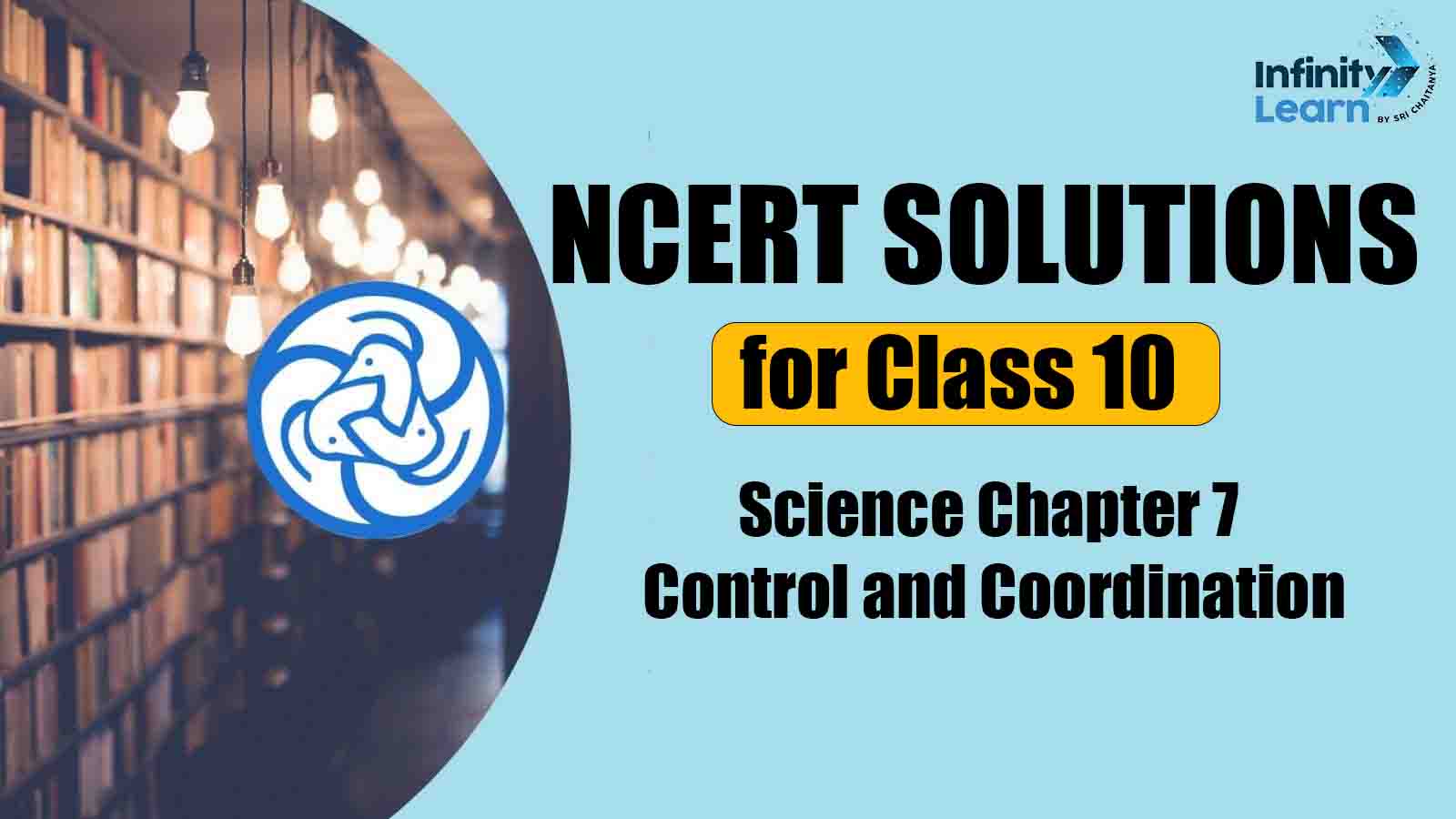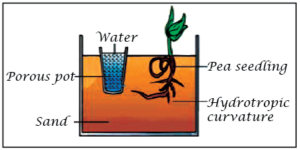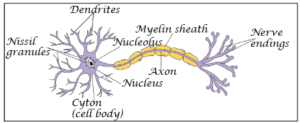Table of Contents
NCERT Solutions for Class 10 Science Chapter 7 Control and Coordination, boost students’ confidence as they prepare for exams. Detailed answers to NCERT textbook questions are provided to help students compare their responses with the sample solutions. These control and coordination class 10 solutions offer clear explanations for the exercises and in-text questions in the NCERT textbooks. Explore essential Control and Coordination Class 10 Questions and Answers to master this chapter’s key concepts and excel in your exams with confidence!
Expertly crafted by experienced professionals, these control and coordination class 10 NCERT solutions ensure a thorough understanding of the chapter. Referring to these solutions can instantly clarify students doubts and enhance their exam preparation for class 10 chapter 7 science. Students can access the ch 7 science class 10 NCERT Solutions through the link provided below.

NCERT Solutions for Class 10 Science Chapter 7: Free PDF Download:
Download our free PDF for NCERT Solutions for Class 10 Science Chapter 7. This comprehensive guide includes detailed questions and answers designed to help students master the concepts with ease. Whether you’re preparing for exams or seeking to enhance your understanding, our solutions provide clear explanations and step-by-step guidance. Get your free copy today and boost your science skills with this essential resource.
Class 10 Science Chapter 7 Question Answer
1.What is the difference between a reflex action and walking ?
Ans.
| REFLEX ACTION | WALKING |
| i) It is a sudden involuntary action. | i) It is a voluntary action. |
| ii) Reflex actions are not under our control. | ii) Walking is under our control. |
Also Check: Metals and Non-Metals Chapter Wise Important Questions Class 10 Science
2.What happens at the synapse between two neurons ?
Ans.
- At the end of the axon, the electrical impulse sets off the release of some chemicals.
- At the synapse, these chemicals cross the gap and start a similar electrical impulse in a dendrite of the next neuron.
3. Which part of the brain maintains posture and equilibrium of the body?
Ans. The posture and equilibrium of the body are maintained by cerebellum of the brain.
4. How do we detect the smell of an agarbatti (incense stick)?
Ans.
- The sense of smell of an incense stick is received by the receptor cells (olfactory cells) of nose.
- The olfactory cells convert the stimulus into electric impulses and carry them to olfactory centre of the brain.
- The brain analyses and detects the smell.
5. What is the role of brain in reflex action ?
Ans.
- The reflex action in which spinal cord is involved, brain acts as the information collecting centre.
- But in some other reflexes such as salivation at the site or smell of food, closing of eyes in bright light the brain acts as the relay centre transferring impulse from sensory to motor neuron.
Also Check: Our Environment Chapter Wise Important Questions Class 10 Science
6. What are plant hormones ?
Ans. The substances or hormones that help to coordinate growth, development and response to environment in plants are called plant hormones or phytohormones.
7. How is the movement of leaves of the sensitive plant different from the movement of a shoot towards light ?
Ans.
| MOVEMENT OF LEAVES OF THE SENSITIVE PLANT | MOVEMENT OF A SHOOT TOWARDS LIGHT |
| i) It is directionless movement caused due to variations in the outside environment. | i) The tropic movements are directional and are caused due to the presence of a specific stimulus. |
| ii) In this case, plant neither moves towards the stimulus nor away from the stimulus. | ii) In this case, the plant either moves towards the stimulus or away from the stimulus. |
8. Give an example of a plant hormone that promotes growth.
Ans. Auxins
Also Check: Control and Coordination Class 10 MCQ with Answers
9. How do auxins promote the growth of a tendril around a support ?
Ans.
- The growth of tendril around the support is caused by the auxin.
- The side of the tendril towards the support has less hormone than the free side.
- So, free side grows more and the tendril coils around the support.
10. Design an experiment to demonstrate hydrotropism.
Ans. Aim : To demonstrate hydrotropism in plants.
Apparatus : Germinating pea seeds, porous pot, soil, water, etc.
Procedure :
- Take a bigger vessel and fill it with soil.
- Put some germinating seeds at one side and put a porous pot on the other side as shown in the figure.
- Fill the porous pot with water regularly.
iv) Observe the setup after two to three weeks.

Observation :
After two to three weeks, we observe that the roots of seedling move towards the water (porous pot).
Conclusion :
Based on the above experiment, we can say that the roots exhibit hydrotropism (bend in the direction of water).
11. How does chemical coordination takes place in animals ?
Ans. Chemical coordination in animals takes place through chemicals secreted by endocrine glands called hormones.
12. Which of the following is a plant hormone ?
a) Insulin
b) Thyroxin
c) Oestrogen
d) Cytokinin
Ans. Cytokinin
13. Why is the use of iodised salt advisable ?
Ans.
- Iodised salt or Iodine enriched salt contains iodine, which is necessary for the production of thyroxine hormone by thyroid gland.
- Thyroxine regulates carbohydrate, protein and fat metabolism in the body.
- Deficiency of iodine in diet can cause ‘Goitre’.
- Hence, doctors advise to take Iodised salt.
14. The gap between two neurons is called a :
- dendrite
- synapse
- axon
- impulse
Ans. Synapse
15. How does our body respond when adrenaline is secreted into the blood ?
Ans. When adrenaline is secreted into the blood :
- the heart beats faster, resulting in the supply of more oxygen to our muscles.
- the blood flow towards digestive system and skin is reduced due to contraction of muscles around small arteries in these organs. This diverts the blood to our skeletal muscles.
- breathing rate also increases because of the contraction of the diaphragm and the rib muscles.
- all these responses together enable the animal body to be ready to deal with the situation.
16. The brain is responsible for :
- thinking
- regulating the heart beat
- balancing the body
- all of the above
Ans. all of the above
17. What is the function of receptors in our body? Think of situations where receptors do not work properly. What problems are likely to arise?
Ans.
- Receptors are the cells that detect the changes in chemical and physical conditions of external and internal environment of an organism.
- Examples of receptors are thermo-receptors, pain-receptors, chemo-receptors and photo-receptors.
- Example of situations where receptors do not work properly is when we suffer from common cold, we can not smell the things properly.
- If receptors do not work properly, the external stimulus can not stimulate receptors and no nerve impulse would be generated.
- The result would be that the body will not respond to such changes in the surroundings.
18. Why are some patients of diabetes treated by giving injections of insulin ?
Ans.
- The blood sugar levels are regulated by a hormone secreted by pancreas called ‘Insulin’.
- If insulin is not secreted in sufficient amounts, the sugar level in the blood rises, causing many harmful effects.
- Hence, some of the patients of diabetes are treated by giving injections of insulin.
19. Draw the structure of a neuron and explain its function.
Ans.

Functions :
- They carry information from receptors to brain and spinal cord.
- They transfer responses from brain and spinal cord to effectors.
20. How does phototropism occur in plants ?
Ans.
- Phototropism is a movement or growth of plants in response to light.
- Auxins are responsible for the phototropism in plants
- Sunlight destroys auxins. Therefore, the side of shoot tip exposed to direct sunlight will have least amount of auxin. Whereas more auxins will be present on the shaded side.
- Phototropism is caused by increased auxin on shaded side and decreased auxin on illuminated side.
- Increased auxin causes increased growth in shoot (towards light).
21. Which signals will get disrupted in case of a spinal cord injury?
Ans.
- The sensory and motor impulses from brain to body parts and vice versa.
- Signals of reflex arc.
22. How does chemical coordination occur in plants ?
Ans. Coordination of developmental process in plants is through small chemical molecules called as plant growth substances (phytohormones).
23. What is the role (is the need) of control and coordination in an organism ?
Ans.
- The body of a multicellular organism consists of a number of components (organ systems) and sub components (organs), each specialised to perform a particular function.
- However, all the components are not required to function all the time at the same speed.
- A system of control is required to allow them to perform, slow down or speed up their working. Further, most activities require the simultaneous or sequential functioning of a number of parts, stopping some and stimulating others.
- For example during feeding, eyes locate the food, nose recognises its smell, hands pick up the food and take it to mouth, mouth opens to receive the food, teeth and muscles take part in its mastication and saliva moistens it. Tongue perceives its taste.
- It aids in moving food in the mouth, chewing and swallowing. All this is possible only through a system of coordination.
24. How are involuntary actions and reflex actions different from each other ?
Ans.
| Involuntary actions | Reflex actions |
| i) Involuntary actions cannot be controlled by us. | i) Reflex actions occur with the involvement of spinal cord |
| ii) No external stimulus is involved. | ii) They take place due to an external stimulus. |
| iii) The actions take place on their own
Eg : Digestion, heart beat, etc. |
iii) They respond quickly to the stimulus
Eg : Sneezing, blinking of eyes, etc. |
25. Compare and contrast nervous and hormonal mechanisms for control and coordination in animals.
Ans.
| Nervous mechanism | Hormonal mechanism |
| i) The information is contained in the form of electric impulses. | i) The information is contained in the form of chemical messengers. |
| ii) The axons and dendrites transfer the information through a coordinated effort. | ii) The information is transferred or transported through blood. |
| iii) The flow of information is huge and the response is quick. | iii) The information travels slowly and the response is slow. |
| iv) Its effects are short lived. | iv) It has prolonged effects. |
Both nervous and hormonal mechanisms are helpful for control and coordination in animals.
26. What is the difference between the manner in which movement takes place in a sensitive plant and the movement in our legs ?
Ans.
| Movement in sensitive plants | Movement in our legs |
| i) The movement that takes place in a sensitive plant such as Mimosa pudica occurs in response to touch (stimulus). | i) Movement in our legs is an example of voluntary actions. |
| ii) For this movement, the information is transmitted from cell to cell by signals as electro-chemical. Plants do not have any specialised tissue for conduction of impulses. | ii) The signals or messages for these actions are passed to the brain and hence are consciously controlled. |
| iii) For this movement to occur, the plant cells change shape by changing the amount of water in them. | iii) Some proteins found in animal muscle cells allow the movement to occur. |
Helpful Resources
- NCERT Solutions for Class 10 Science
- NCERT Solutions for Class 10 English
- NCERT Solutions for Class 10 Maths
- NCERT Solutions for Class 10 Social Science
Control And Coordination Class 10 NCERT Solutions
The nervous system-muscular tissue relationship is explained in Chapter 7 of NCERT Solutions for Class 10 Science. This topic also covers the anatomy of the human brain, tissue protection, and nervous tissue function. It summarises the chemical coordination of animals and plants. Some of the most significant hormones and their functions are discussed in Chapter 7 of Science NCERT Solutions for Class 10. A concise picture depicting the location of various glands in the human body and a table detailing the functioning of various glands were used to clarify concepts.
NCERT Solutions for Class 10 Science Chapter 7 Key Points for Coordination and Control
- The language used in NCERT Solutions is simple enough for students to understand.
- These solutions would be valuable for CBSE board examinations, Science Olympiads, and other competitive exams.
- All concerns in the respective NCERT textbooks are entirely resolved in this book.
- Our subject specialists prepare these solutions after conducting a significant study on each topic in order to present students with accurate and reliable information.
- All questions include extensive answers to assist students in their preparations.
NCERT Solutions for Class 10 Science Chapter 7 FAQs
What will I learn from NCERT Solutions for 10th class Science Chapter 7?
Reflex action, voluntary action, and involuntary action are all explained in Chapter 7 of NCERT Solutions for Class 10 Science. The nervous system's control and coordination are briefly outlined. Hormone action is regulated by the feedback mechanism. Messages are transmitted through electrical impulses.
Why should I get the NCERT Solutions for Class 10 Science Chapter 7 PDF from INFINITY LEARN?
The NCERT Solutions use simple language to help students achieve good grades in their board exams. The answers will be useful not only for board exams but also for a variety of competitive exams and science Olympiads. Students' worries about the NCERT textbooks are dispelled by the fully resolved solutions. Subject specialists create answers that are accurate and real in order to boost student confidence. The detailed solutions to all of the questions aid students in their preparation for the board exam.
How do you respond to challenging problems in NCERT Solutions for Class 10 Science Chapter 7?
Students must initially focus on mastering the fundamental concepts in order to solve difficult queries. Core sections should be given higher emphasis than other areas. A clear understanding of the chapter not only aids students in answering problems but also in implementing new ideas in the future. Students interested in pursuing this subject in further education should be familiar with concepts such as nerve system tissue connection, reflex actions, and phototropism.








